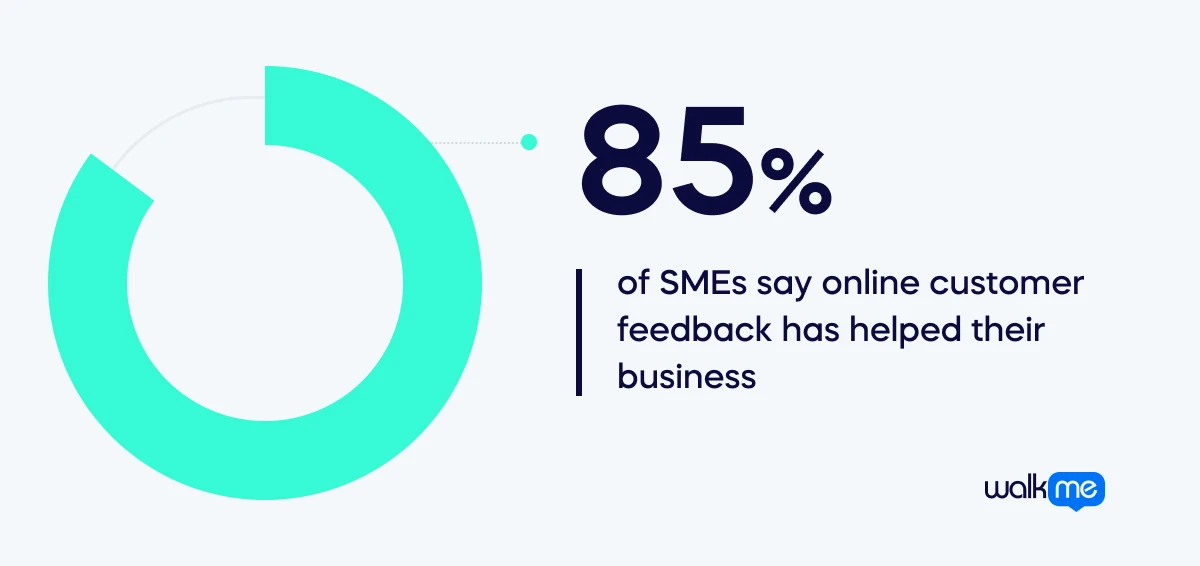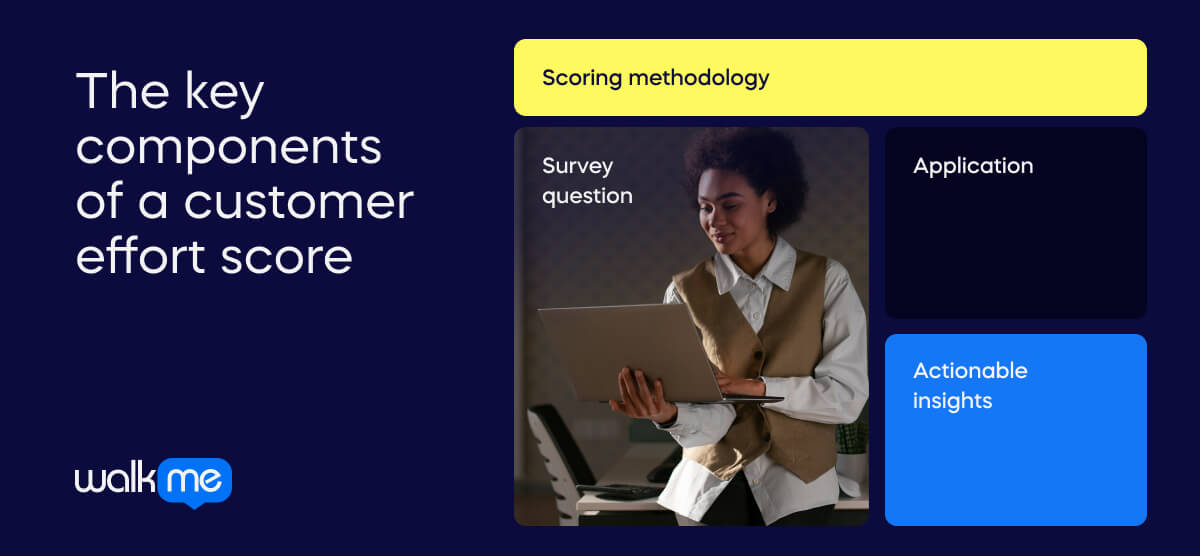Customer effort score

Table of contents
- What are the key components of a customer effort score?
- Customer effort score (CES) vs. customer satisfaction score (CSAT)
- Use cases for customer effort score
- What are the advantages of customer effort scores?
- What are the challenges of customer effort scores?
- How can DAPs help with customer effort scores?
A customer effort score (CES) measures how easily customers interact with a company. It shows how much effort a customer needs to solve a problem, make a purchase, or get help. CES is usually measured by asking, “How much effort did you put into handling your request?” Customers rate their experience on a scale where a lower score means less effort. CES is important because it predicts customer loyalty. When customers find it easy to get help or use a product, they are more likely to return and recommend the company.
CES also helps companies find problem areas in their service or product. Companies can make customers happier and improve their business by lowering the effort needed. CES differs from other metrics like Net Promoter Score (NPS) or Customer Satisfaction (CSAT) because it focuses only on effort. Gartner reveals that just 9% of customers who have a low-effort experience become disloyal, compared with 96% who have a high-effort experience – proving the value of CES. Furthermore, 85% of SMEs say online customer feedback has helped their business.

What are the key components of a customer effort score?

It’s important to understand how CES surveys work, how scores are calculated, where CES is used (like customer service and websites), and how it helps companies improve. This knowledge helps businesses that want to make it easier for customers to use their products and services. By focusing on CES, companies can find and fix problems that make processes hard for customers, leading to better experiences and more loyal customers. Let’s take a closer look at the key components:
Survey question
CES asks simple questions like, “How much effort did it take to handle your request?” Customers rate their effort from 1 (easy) to 5 or 7 (hard).
Scoring methodology
Scores are added up and averaged to get an overall CES score. Lower scores mean it’s easier for customers to work with the company.
Application
CES is used in customer service, websites, and purchases. It finds out where customers struggle.
Actionable insights
CES provides useful information. Companies can fix areas where customers have lots of trouble, making processes smoother.
Customer effort score (CES) vs. customer satisfaction score (CSAT)
Don’t get customer effort scores and customer satisfaction scores mixed up.
- CES measures how hard it is for customers to use a product or service.
- CSAT measures how happy customers are with their experience.
Knowing the difference helps businesses improve customer interactions and satisfaction. Here’s a more comprehensive overview:
| Customer effort score | Customer satisfaction score | |
| Definition | Measures how hard it is for customers to use a company’s products or services. | Measures how happy customers are with a product or service overall. |
| Focus | Looks at the ease of customer interactions and how much effort customers need to put in. | Focuses on how satisfied customers feel with a product or service. |
| Techniques | Asks customers to rate the effort they had to make, often on a scale. | Asks customers to rate their satisfaction levels, usually with a survey. |
| Goals | Aims to make interactions easier for customers and improve efficiency. | Aims to keep customers happy and build loyalty. |
| Examples of use | Used in customer service to see how easy it is for customers to get help. For instance, CES can measure how much effort it takes to complete an online purchase. | Used after a service to see how satisfied customers are. For example, CSAT can measure satisfaction with the online shopping experience. |
Use cases for customer effort score
Let’s examine how customer effort score (CES) is used in different business situations. These scenarios show how CES helps to find and fix customer problems. Here are three examples of CES in action.
Online shopping experience
The customer effort score (CES) provides valuable insights into the ease with which consumers can navigate and complete purchases on e-commerce platforms. Following a transaction, customers assess the effort to find and buy products. A high CES indicates that users faced challenges during the shopping process, such as difficulties with navigation or the checkout procedure. This feedback highlights the need for businesses to simplify their online interfaces and streamline the purchasing process. Enhancing these aspects can significantly improve the shopping experience, increasing customer experience (CX) and sales.
Customer support efficiency
Customer support efficiency can be effectively measured using the Customer Effort Score (CES). This score assesses how easily customers can obtain help when they encounter issues. After interacting with support, customers rate the effort needed to resolve their problems. A high CES score suggests that the support process was cumbersome and challenging for users. Such scores reveal inefficiencies in the support system, indicating areas where improvements are necessary. Enhancing support services to reduce wait times and streamline issue resolution can make the customer support experience more efficient and satisfactory.
Software onboarding process
The Customer Effort Score (CES) is crucial for evaluating the onboarding process of new software users. This metric gauges how straightforward it is for users to set up and start using the software. New users provide feedback on the effort required to become acquainted with the software. A high CES score typically signifies the complex and difficult onboarding process. This insight calls for businesses to simplify the initial setup and user experience, making it more intuitive and user-friendly. Improving this process can lead to better user satisfaction and smoother software adoption.

What are the advantages of customer effort scores?
Using customer effort scores (CES) comes with many advantages for businesses. Companies can improve customer satisfaction and loyalty by making processes easier for customers. This leads to better customer experiences, cost savings, and clear insights for improvement. Businesses can create better experiences and gain long-term benefits by lowering customer effort. Let’s look at all the benefits of using CES in more detail.
Better customer experience
Customer Effort Scores (CES) are instrumental in identifying areas where customers encounter difficulties, allowing businesses to refine and streamline processes. Companies can significantly enhance the overall customer experience by focusing on minimizing customer effort. When pain points are addressed, interactions become smoother, leading to a more satisfying and enjoyable customer experience.
More customer loyalty
An effortless experience is a powerful driver of customer loyalty. Customers who find it easy to interact with a company are more likely to return for future transactions. Simplified processes foster a sense of convenience and satisfaction, encouraging customers to stay loyal to the brand rather than seeking alternatives.
Clear insights
CES provides straightforward data that illuminates how much effort customers need to expend. This clarity helps businesses make informed, data-driven decisions. Understanding the specific areas where customers struggle allows companies to target their improvements more effectively and measure the impact of changes.
Cost savings
Reducing areas of high customer effort can lead to substantial cost savings. Fewer customer service inquiries and complaints translate to lower operational costs. Additionally, streamlined processes enhance overall efficiency, contributing to reduced expenses and better resource management.
Higher customer retention
Customers who experience minimal effort in their interactions with a company are less likely to switch to competitors. A low-effort experience retains customers and builds a strong foundation for long-term relationships, reducing churn rates and fostering brand loyalty.
Predict future behavior
CES data can provide predictive insights into customer behavior. Businesses can anticipate and proactively address potential issues by analyzing effort levels. This foresight allows companies to implement preventative measures to avoid future customer dissatisfaction and improve overall service quality. Competitive Advantage Companies prioritizing ease of use and customer convenience can differentiate themselves from competitors. Focusing on minimizing customer effort enhances the company’s reputation and appeal, attracting more customers who value seamless experiences over competitors.
What are the challenges of customer effort scores?
Now, let’s explore the challenges of customer effort scores (CES). Businesses use CES to measure the effort customers put into using their products or services, aiming to make processes easier for them. However, using CES effectively can be tricky, with specific problems businesses need to handle to understand and improve customer satisfaction.
Understanding responses
Interpreting what different customers mean by their effort levels can be challenging. The subjective nature of effort can vary widely among individuals, making it difficult to gauge a consistent understanding of customer feedback. This variability requires careful consideration to accurately address the underlying issues.
Different situations
Customers face varying circumstances that affect their perception of effort. Factors such as the complexity of the product or service, individual expectations, and previous experiences all play a role. Accounting for these diverse situations can complicate efforts to effectively standardize and address customer concerns.
Survey design
Creating CES surveys that genuinely reflect customer sentiment without introducing bias is a complex task. Survey design must ensure that questions are clear, unbiased, and capable of capturing true effort levels. Any shortcomings in survey design can lead to inaccurate data and misguided improvements.
Using the data
Translating CES data into actionable improvements requires thoughtful analysis and implementation. Determining the most effective strategies to reduce customer effort based on CES findings involves careful planning and execution. Poor utilization of this data can lead to ineffective changes and missed opportunities for enhancement.
Consistency
Maintaining consistency in CES measurements over time is essential for accurately tracking progress. Variability in how data is collected, interpreted, or reported can obscure true trends and hinder measuring changes’ impact. Ensuring reliable and consistent CES tracking is crucial for effective long-term improvements.
How can DAPs help with customer effort scores?
Digital adoption platforms (DAPs) like WalkMe can make a big difference in customer effort scores (CES) by focusing on making customer interactions easier and more efficient. Here’s how they help:
Streamlined onboarding
They guide users through software, helping them learn and use features well. This makes it simpler for customers to get started and benefit from the software.
| How can WalkMe help?WalkThrus: This feature shows users step by step how to use the main features, making it easy to get started and use the software effectively right away. This helps users get the most out of software as soon as they use it. |
Personalized support
Providing personalized support in apps, they predict what users need and offer guidance on where users work. This helps users solve problems quickly, improving CES scores.
| How can WalkMe help?Smart Tips & Overlays: These predict what users might need help with. They provide tips or quick tutorials within the software. User segmentation: WalkMe allows users to customize WalkThrus or Smart Tips for different groups of users. It’s like having tours designed specifically for beginners or advanced users. This personal touch ensures people get the most helpful information when needed. |
Continuous learning
Including analytics to track how users interact and insights to show where users struggle so businesses can improve. This makes using the software easier over time.
| How can WalkMe help?WalkMe Analytics: This feature watches how users navigate software. By studying this data, businesses can see where users have trouble and what parts are unclear. This helps them keep improving software and WalkMe guides (like WalkThrus and Smart Tips), making it easier for everyone to learn and use. |
Feedback loops
Gathering user feedback to see how they feel and what they need helps companies make changes to keep improving, reducing customer effort.
| How can WalkMe help?WalkMe Surveys: This feature lets companies put surveys right in their software. They can be quick polls or questions to find out how users feel and where processes can get better. Understanding what users think helps businesses keep making their software, and WalkMe guides better, making customer experiences easier. |